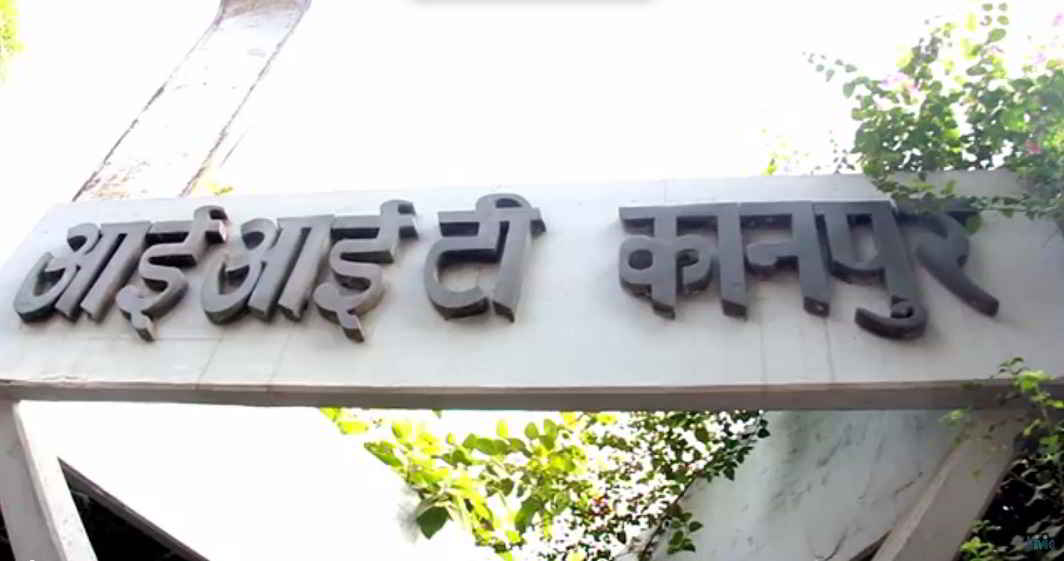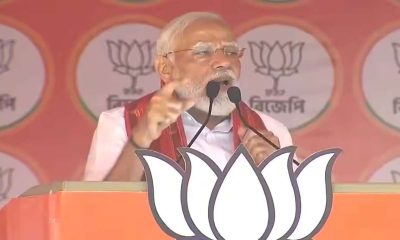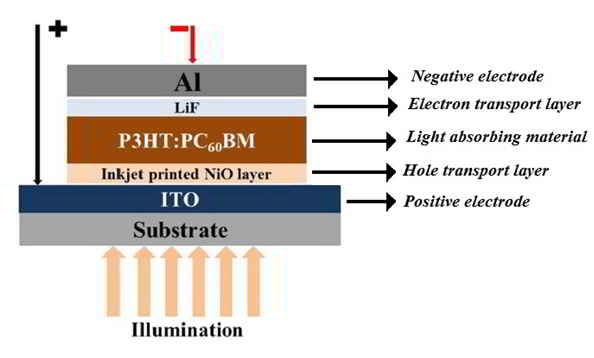Gadgets
IIT Kanpur scientists use inkjet printers to ‘print’ organic solar cells

[vc_row][vc_column][vc_column_text]By Namrata Dave
Researchers at the Indian Institute of Technology, Kanpur have used technique of inkjet printing to print thin nickel oxide films to make organic solar cells.
Organic solar cells contain carbon-based and light-absorbing materials that can convert solar energy to electricity. When a photon of light falls on an organic solar cell, its energy is absorbed by an electron of the light-absorbing material. With this energy, the electron is able to jump to a higher energy state. Due to this jump, a ‘hole’ is left back in the place where the electron earlier was. However, strong forces of attraction bind the electron and hole together, and current can only flow through the cell if the negatively charged electron and positively charged hole are separated and directed to different electrodes. This separation is achieved by an electron transporting layer and a hole transporting layer respectively. These layers are very thin films of compounds which are deposited on either side of the light absorbing material.
Nickel Oxide (NiO) demonstrates properties that are ideal for use as a hole transporting layer, but previous studies have shown that it has been a challenge to prepare thin NiO films on a large scale.
In their study, published in journal Scientific Reports, researchers from IIT Kanpur have attempted to overcome this roadblock by using the technique of inkjet printing. In inkjet printing of NiO films, the ‘ink’ is NiO and the ‘paper’ is a substrate of glass coated with a material that serves as the positive electrode. By testing various experimental conditions, the researchers were able to prepare uniform, smooth NiO films as thin as 18 nanometres by using NiO ink having drops of a specific size, and by providing the substrate with a UV-Ozone treatment prior to printing.
It is important for the hole transporting layer to be as transparent as possible to ensure that maximum light goes through to the light absorbing material. The researchers found that the inkjet-printed NiO film showed different degrees of transparency at different temperatures, and was able to transmit a maximum of 89% of the light falling on it, by thermally treating the film at 400 ºC.
The next part of this study was to test the performance of this inkjet-printed NiO film in an organic solar cell device. In such a device,the hole transporting layer must bond well with the light absorbing material to provide a smooth passage for the positively charged ‘holes’ of the material to reach an electrode. For this, they chemically and thermally treated the NiO film, and were able to drastically improve the conversion efficiency of the device from 0.75% to 2.67%.
NiO films can also be prepared by another technique known as ‘spin coating’, but this technique is not suitable for large scale production and a lot of raw material is wasted. This study shows that structurally and chemically identical NiO films can be easily manufactured on a large scale at a low cost by using the technique of inkjet printing.
This research team included Arjun Singh, Shailendra Kumar Gupta and Ashish Garg from Department of Materials Science and Engineering at the Indian Institute of Technology, Kanpur. (India Science Wire)[/vc_column_text][/vc_column][/vc_row]
Gadgets
WhatsApp to introduce Native File Sharing feature similar to Apple’s AirDrop
Users can choose to be visible to others without disclosing their phone numbers to people who are not their contacts.

A Meta-owned messaging platform, WhatsApp is all set to introduce a new feature that allows Android users to share files with another user nearby. According to reports, the feature will be developed similar to Apple’s AirDrop.
The file sharing feature nearby is not currently available for beta testers. However, according to a report from WhatsApp feature tracker WABetaInfo, it seems that the feature will soon be introduced. The report reveals a screenshot that shows an option within the app stating, to share files with people nearby, along with a list of nearby users.
It is interesting to note that users can choose to be visible to others without disclosing their phone numbers to people who are not their contacts. In order to share files with other users, one needs to wait for nearby users to accept their request. The process involves a unique interaction, where nearby users can shake their device to receive incoming share requests. It is important to note that this feature is designed with end-to-end encryption to ensure user privacy.
In the upcoming update, WhatsApp is expected to introduce a nearby file-sharing feature. However, the current beta version for Android, which is 2.24.2.20, has addressed a camera issue. Some Android beta testers have reported difficulties in launching the camera within the app after the 2.24.2.13 update. Upon launching, users were presented with an error message that said, can’t start camera, please restart your device. This issue persisted even after restarting the device or relaunching the app.
The latest beta update of WhatsApp, located at 2.24.2.20, has fixed the camera bug. This allows users to launch the camera within the app and share photos and videos with their contacts without any interruptions. As WhatsApp continues its efforts to improve its features and address bugs, users can expect a better messaging experience on the platform.
Gadgets
Meesho mega blockbuster sale: E-commerce platform to offer 80 percent discount on electronics
The e-commerce platform’s first mega blockbuster sale will sell more than 400 brands directly with the help of authorised partners on its digital store called Meesho Mall.

Ahead of the festive season, e-commerce platform Meesho’s mega blockbuster sale is starting on Friday, October 6, 2023. The platform will provide a massive discount of up to 80 percent on different categories such as essentials, accessories, electronics, footwear, etc.
The blockbuster sale is scheduled to conclude on October 13, 2023. Notably, the Softbank backed e-commerce platform is starting its festive sale a day before Flipkart or Amazon’s festive sale goes live. The e-commerce platform’s first mega blockbuster sale will sell more than 400 brands directly with the help of authorised partners on its digital store called Meesho Mall.
Reportedly, the platform also added over 50 lakh new customers during these sales. More than 75 percent of the demand was received from Tier-II cities, including Amravati, Aurangabad, Dehradun, Nellore, Solapur, and Warangal. The platform further claimed that they have added more than 2 lakh sellers in the past two years.
Recently, Meesho affirmed that they have received over 10 million (approx) from its pre-festive sales during Onam, Raksha Bandhan, and Ganesh Chaturthi. The platform has more than 14 lakh sellers, selling approx 12 crore products in 30 different categories.
In an effort to increase the seller base, the company announced the onboarding of non-GST sellers on the platform earlier this week. The GST council announced to permit the e-commerce platform to onboard sellers with turnover of up to Rs 40 lakh.
Prior to Meesho’s Mega Blockbuster Sale, the company introduced a loyalty programme during which eligible users will earn Smart Coins, which the user can redeem every time they make the purchase of any products on the platform.
As per Redseer, over 140 million shoppers are likely to make purchases during the festive season. This will enhance the Gross Merchandise Value (GMV) of the Indian e-commerce sector by 18 to 20 per cent and may touch Rs 90,000 crore as compared to Rs 76,000 crore last year.
Phones & gadgets
Apple launches iPhone 15 series, India price, features, availability
The iPhone 15 series will be available in India from September 22 but iPhone lovers can also pre-order, starting from September 15 onwards.

Apple launched its most anticipated iPhone 15 series, including the iPhone 15, iPhone 15 Plus, iPhone 15 Pro and iPhone 15 Pro Max during the Wonderlust event globally on September 12 night.
The iPhone 15 series will be available in India from September 22 but iPhone lovers can also pre-order, starting from September 15 onwards.
People can buy a new iPhone 15 or upgrade it to the old one. There are five colours available for the people.
According to reports, Apple has been manufacturing the iPhone 15 series in India and China. Apple has moved 7% of its iPhone production to India. Previously, India was not making the newest models. The Centre’s production-linked incentive (PLI) scheme for smartphones played a part in Apple moving its production to India.
The new iPhone 15 has been launched with the same starting price as its prototype, the iPhone 14. The 128GB variant is priced at Rs 79,900, while the 256GB variant costs Rs 89,900. For people who need more storage, the 512GB variant is available for Rs 1,09,900.
This latest iPhone series puffs a 6.1-inch display and comes in five different colours which are pink, yellow, green, blue, and black. While the design remains the same as the previous models, the iPhone 15 features a dynamic island notch instead of the usual notch, which was highly popular among the iPhone 14 Pro phones.
The camera part of the iPhone series has undergone significant upgrades, the new iPhone 15, with an enhanced 48-megapixel primary sensor replaces the 12-megapixel dual camera system which was available in the previous iPhone 14. This significant improvement promises better low-light photography and portrait shots.
The tech giant announced that the iPhone 15 has an all-day battery life, making it more convenient for users to go about their daily activities without worrying about their phone’s battery.
The iPhone 15 Pro models feature a lighter body and thinner bezels. The new AirPods Pro with USB-C charging case will support Lossless Audio with Apple Vision Pro.
Additionally, the iPhone 15 is powered by Apple’s A16 bionic processor, an upgrade from the A15 bionic chipset used in the previous iPhone 14 and iPhone 14 Plus models. The Pro models had the faster and better A16 chip, but now this feature is available in all iPhone 15 models.
The USB-C port on the standard iPhone 15 and iPhone 15 Plus remain limited to lightning speeds up to 480 Mbps. The iPhone 15 Pro and iPhone 15 Pro Max support USB 3 speeds up to 10 Gbps. People will need to buy a separate 1-meter Thunderbolt 4 Pro cable for Rs 5,724 or Rs 10,701 for the 1.8-meter cable to support faster speeds.
The dynamic island notch feature, which can adjust its size according to notifications, was widely discussed before the launch of the iPhone 15. This unique feature can now be available in all models of the phone.
Another important feature of the iPhone 15 is the shift to the USB Type C charging port. Apple has abandoned the lightning port in favour of the more commonly used USB Type C charging port. This means, there is no longer a need for a special iPhone charging cable to be carried around everywhere you go.
-

 Cricket news17 hours ago
Cricket news17 hours agoIPL 2024: Yashasvi Jaiswal hits brilliant century to help Rajasthan Royals beat Mumbai Indians by 9 wickets
-

 2024 Lok Sabha Elections15 hours ago
2024 Lok Sabha Elections15 hours agoNCP (SP) leader Sharad Pawar says Prime Minister Narendra Modi is trying to create fear like Russian President Vladimir Putin
-

 Entertainment15 hours ago
Entertainment15 hours agoMithun Chakraborty, Usha Uthup honoured with Padma Bhushan
-

 Entertainment13 hours ago
Entertainment13 hours agoFan jumps on stage and hugs Atif Aslam during concert, video goes viral
-

 2024 Lok Sabha Elections14 hours ago
2024 Lok Sabha Elections14 hours agoPrime Minister Narendra Modi says listening to Hanuman Chalisa under Congress rule is a crime
-

 Entertainment10 hours ago
Entertainment10 hours agoManisha Koirala reveals reason for rejecting Dil To Pagal Hai, says regrets that decision
-

 2024 Lok Sabha Elections9 hours ago
2024 Lok Sabha Elections9 hours agoPM Modi says Congress leaders consider themselves above Lord Ram
-

 India News17 hours ago
India News17 hours agoArvind Kejriwal given insulin in Tihar jail after sugar levels touch 320








